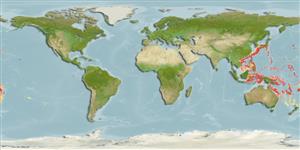Common names from other countries
Environment: milieu / climate zone / depth range / distribution range
Οικολογία
Θαλασσινό(ά) βενθικό(ς); εύρος βάθους 148 - 956 m (Ref. 116586). Tropical
Disjunct distribution: Northwestern Pacific off southern Japan, Taiwan and the northern Philippines and Southwestern Pacific from the Coral Sea to Vanuatu; none from the tropical low latitudes.
Μέγεθος / Βάρος / Age
Maturity: Lm ? range ? - ? cm
Max length : 11.0 cm SL αρσενικό/απροσδιόριστο; (Ref. 116586)
Short description
Κλείδες προσδιορισμού | Μορφολογία | Μορφομετρία
Εδρικές άκανθες: 3; Μαλακές εδρικές ακτίνες: 6. This deep-bodied species is distinguished by the following characters: convex dorsal head profile; A III + 6 in >6.5 cm SL specimens; pectoral-fin rays 16-18 with length 21.5-27% SL; gill rakers 15-18; pseudobranchial filaments 16-23, increasing with size; first anal-fin pterygiophore is long, slightly forward bent, with very broad tip and hollow; ectopterygoid with a single row of denticles; orbit diameter 11.7-13.3% SL; otolith compressed (OL:OH = 1.45-1.55) (Ref. 116586).
Found on the continental slope (Ref. 75154).
Life cycle and mating behavior
Maturities | Αναπαραγωγή | Spawnings | Egg(s) | Fecundities | Προνύμφες
Schwarzhans, W.W. and A.M. Prokofiev, 2017. Reappraisal of Synagrops, Günther, 1887 with rehabilitation and revision of Parascombrops Alcock, 1889 including description of seven new species and two new genera (Perciformes: Acropomatidae). Zootaxa 4260(1):1-74. (Ref. 116586)
IUCN Red List Status (Ref. 130435)
CITES (Ref. 128078)
Not Evaluated
Threat to humans
Harmless
Human uses
Εργαλεία
Special reports
Download XML
Διαδικτυακές πηγές
Estimates based on models
Preferred temperature (Ref.
115969): 15.3 - 26.8, mean 22.3 (based on 220 cells).
Phylogenetic diversity index (Ref.
82804): PD
50 = 0.5001 [Uniqueness, from 0.5 = low to 2.0 = high].
Bayesian length-weight: a=0.00955 (0.00424 - 0.02152), b=3.02 (2.82 - 3.22), in cm Total Length, based on LWR estimates for this (Sub)family-body shape (Ref.
93245).
Τροφικό Επίπεδο (Ref.
69278): 3.5 ±0.5 se; based on size and trophs of closest relatives
Fishing Vulnerability (Ref.
59153): Low vulnerability (10 of 100).
